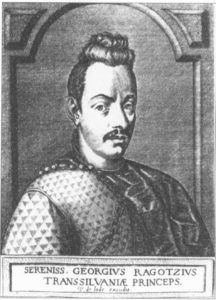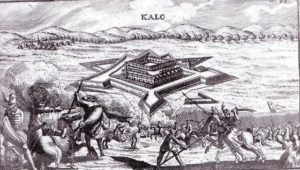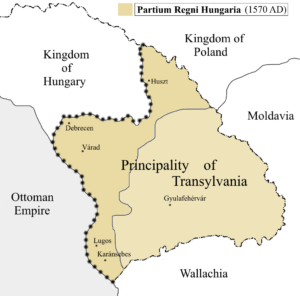Prince Rákóczi I György of Transylvania (ruled from 1630 to 1648)
„Si Deus pro nobis, quis contra nos” (If God is with us, who is against us?) – it was his favorite saying.

Rákóczi I György (1593 – 1648) was an important Hungarian nobleman who was Prince of Transylvania from 1630 until he died in 1648. During his 18 years of reign, Transylvania grew politically and economically stronger which was made possible by the relative peace in the region. In addition to peaceful development, his reign brought moderate foreign policy successes.
He was a well-educated and tolerant, “modern” absolute ruler with good military skills and experience. As a strong and independent sovereign ruler of Transylvania, an area twice as big as modern-day Hungary, he was indeed in a position to make a difference in the Thirty Years’ War.

He was born on 8 June 1593 in the castle of Szerencs, in the recently gained domain of his father, Zsigmond. In 1605 he served as a page in the court of Prince Bocskai István in Kassa (Kosice, Kaschau). After Bocskai died in 1606, he rejoined his father, Rákóczi Zsigmond in Transylvania. Zsigmond was elected Prince of Transylvania in 1607 but resigned a year later. However, since the Rákóczi estates were located in the territory of the Kingdom of Hungary, for example in Borsod and Sáros counties, György left Transylvania after his father’s abdication and retired from public life for a while, he followed his father to his domains in 1608.

He was a young man when he became the Captain of Ónod castle and the Chief Comes of Borsod County in 1615. The next year, he married Lórántffy Zsuzsanna. She brought large domains into the marriage, they were in Zemplén County. It was when the Rákóczi family could get hold of the castle of Sárospatak, and Munkács. These castles later proved vital to the family. They had four sons, one of them was called also György, later he became Prince of Transylvania. (Prince Rákóczi György II ruled from 1648 to 1657.)

In 1619, György joined Prince Bethlen Gábor’s invasion of the Kingdom of Hungary, ruled by King Ferdinand II. Bethlen was fighting for the unification of the national kingdom.
Prince Bethlen appointed him Chief Captain of Upper Hungary. György commanded a wing of Bethlen’s army, which was sent to oppose a Polish army coming to the aid of Ferdinand. The Polish force defeated Rákóczi’s force at the Battle of Homonna (Homoneau, Humenné) on 23 November. As a result, Bethlen had to give up his attack on Vienna and make peace – as we had said, it was that attack on Vienna when its suburb was taken. It is an interesting addition to Rákóczi’s character that when he was with Bethlen’s army he received the news that his wife was about to deliver a baby. He didn’t care that Bethlen was dismayed and left the army behind just to be near his wife’s bed.

Rákóczi became one of the prince’s closest confidants and remained in Bethlen’s service till Bethlen died in 1629. Bethlen Gábor was briefly succeeded by his widow Catherine, and then his brother Bethlen István. But the Transylvanian Diet soon turned to György instead because they disliked Catherine’s rule. Because of the incompetence of his heir, Catherine of Brandenburg (r. 1629-1630), which led to a crisis of power, Rákóczi emerged as a likely candidate for the throne.

At first, the princess’s brother-in-law, Bethlen István, also wanted to give him the throne of Transylvania, but after he had succeeded in deposing Catherine, he wanted to take power himself; however, Rákóczi György did not want to miss this opportunity, so he set off for Transylvania with the support of the Pasha of Szolnok. In the end, there was no armed confrontation between Bethlen and Rákóczi, as the Porte, showing complete disinterest in the matter, sent two athames and the new ruler was chosen by Catherine of Brandenburg. The widow’s hatred for Bethlen István led her to read out the document issued to Rakóczi György on 26 November 1630 in Segesvár, and the lucky winner took the prince’s oath. Thus, on 1 December 1630, in Segesvár (Schäsbrich, Sighisoara), the Estates elected Rákóczi as prince. However, he had to confirm his rule by demonstrating sufficient military power.

On March 15, 1631, the troops of Prince Rákóczi defeated the troops of the Palatine Esterházy Miklós in the battle of Rakamaz
The accession of Prince Rákóczi to the throne was a great thorn in the side of the leading politicians of the Kingdom of Hungary, especially the Hungarian Palatine Esterházy Miklós. Therefore, he organized his troops against Rákóczi even before the election of the prince in December 1630. It is said that he was able to gather 5,000 armed men in Nyitra and then marched to the Upper Tisza Valley via Kassa. He fortified Kálló and Szatmár and built a fortress in Rakamaz. His small army was not enough to defeat the prince.

Rákóczi, of course, did not wait idly for the attack, he tried to prevent the Palatine’s move. Even the archbishop of Esztergom, Pázmány Péter, secretly helped him. His army supported the Hajdú soldiers of Zólyomi Dávid. The deployment of troops in January was followed by inactivity in February. None of the troops attacked, and Esterházy attributed this to Rákóczi’s cowardice. When the weather improved, his troops crossed the Tisza to the Rakamaz entrenchments.

Rákóczi’s spies reported enemy troop movements in time. He gathered the troops of his lieutenants, Bethlen István the Younger and Zólyomi Dávid, and ordered the attack when the German cavalry and part of the Palatine army set out for Nánás. Zólyomi’s and Bethlen’s troops first burned Kálló and then crushed the army that had entered Nánás. Then Rákóczi launched an attack on the Rakamazi entrenchments.

The prince encouraged the Hajdú soldiers, who were reluctant to attack fortresses and castles, by saying that if they ran away, their families, houses, and lands would regret the enemy’s victory. This hardened the hearts of the Hajdús, and under the fire of the enemy’s guns and rifles, the cavalrymen also rushed to the battlements on foot, and although they suffered heavy losses, they soon broke through behind the defensive works. The guns were aimed at the still defending enemy and this had its effect. The fire of the cannons drove the royal commanders back and panic broke out.

The defenders rushed to the ferry, pushing each other into the water. The boatmen also fired shots from the shore, several boats sank and many drowned in the cold water. Rákóczi’s army took many prisoners and rich booty. At the time of the battle, Esterházy was still in Kassa and was about to leave when everything came to an end. Rákóczi returned from Várad with the news of the victory.

Esterházy would have been the Habsburgs’ candidate for the Transylvanian throne, but after defeating him, King Ferdinand II concluded a treaty in Kassa (Kaschau. Kosice) in 1631 and Rákóczi was accepted as a prince. In return, he undertook to remove the Hajdú troops. Seeing this, the Sultan also recognized him and sent his confirming “athame” in June of the following year.
We have to add, that at this time the Habsburgs were preoccupied with the struggles of the Thirty Years’ War – which is why Ferdinand II (r. 1619-1637) did not intervene in the Transylvanian power struggle of 1629-30 – and the Porte was paralyzed by a series of Janissary rebellions.
You can read more about Catherina’s reign here:
https://www.hungarianottomanwars.com/essays/catherine-of-brandenburg-wife-of-prince-bethlen/

Rákóczi did everything in his power to force all Transylvanians to accept his rule, including the use of violence. He considered the Transylvanian Sabbatarians, an extreme branch of the Unitarian Church, to be dangerous, so he fabricated a trial against them and expelled them from the country. The Transylvanian Estates were not happy with him, so Rákóczi always had to hold the reins with a strong hand. Incidentally, the Transylvanian rulers always had stronger and more absolutist power concentrated in their hands than the Habsburgs or any other contemporary Western monarchs.

The perception of the prince’s domestic policy is not necessarily positive, as Rákóczi began to confiscate property on an unprecedented scale in Hungarian history, among his political opponents and the influential Transylvanian aristocracy. However, this later had a positive effect, as it led to the centralization of Transylvania and the strengthening of the prince’s power. It was this stability that allowed for peaceful development and the continuation of Bethlen’s golden age, characterized by generous support for Reformation education and a boom in book printing.
Read more about the semi-independence of the Transylvanian Principality:
https://www.hungarianottomanwars.com/essays/transylvanian-principality-a-vassal-state-of-the-turks/
As far as the Ottomans were concerned, Rákóczi was even more independent of the Turks than Bethlen had been, even refusing to pay the annual taxes, which was a casus belli. The Turks were annoyed and the Pasha of Buda gave troops to Bethlen István, the younger brother of the late Prince Bethlen Gábor, to drive Rákóczi out of Transylvania. However, Rákóczi defeated the Pasha of Buda at the Battle of Nagyszalonta on 6 October 1636. This victory strengthened his position in the Sublime Porte. Four years later he formed a coalition with the Polish king Sigismund III against the Sultan.

He could afford an independent foreign policy, neither the Sultan nor the Habsburg Emperor could interfere in his actions. For example, he meddled in the internal affairs of the Wallachian and Moldavian voivods, trying to keep them loyal to him alone. He also took an active part in the political affairs of the West. As far as King Gustav Adolf was concerned, Rákóczi followed Bethlen’s footsteps and sent a delegation to Sweden, but it was too late as the Swedish monarch died. As a result, Rákóczi couldn’t join the Swedes against the Habsburgs to take back Hungary from the Austrian usurpers.

The delay in their coalition was because the Swedish king wanted his military support against the Austrians unconditionally. But Rákóczi had his conditions: he wanted to keep his lands and the religious freedom of Transylvania. The Habsburgs had done everything they could to prevent Rákóczi’s intervention in the Thirty Years’ War: they had bribed the Ottoman Serasker (the Sultan’s military chief), who threatened Rákóczi with sending Crimean Tatar and Turkish raiders to Transylvania if he tried to attack the Austrians. When this Serasker received his “silk thread” from Sultan Murad, this obstacle was removed.

So it was that a decade later, Rákóczi was free to choose to side with the Swedes when he heard that Torstenson had invaded Austria at Olmütz after 1642. Rákóczi occupied the whole of Upper Hungary from the Habsburgs – similar to his fellow Transylvanian princes such as Bethlen and Bocskai. The lands of the Kingdom of Hungary north of the Danube were in his hands. However, the majority of the Hungarian estates of Royal Hungary did not support him. His army was on the march in February 1644 to join Torstensson and meet him in Vienna. In the end, the prince joined the Swedish army not in Vienna but in Bohemia, where they were besieging Brno. But why?
He was in no hurry to ruin the Austrians. In this respect, his thinking may have been similar to that of King Báthory István, who, as Polish king, balanced power between the Habsburgs and the Ottomans. Here’s the background, without which we couldn’t fully understand why. In 1644 he intervened in the Thirty Years’ War, allying himself with the French and the Swedes. He declared war on the new emperor, the Habsburg Ferdinand III, but not to crush him.

I won’t go into the details of how Rákóczi’s army was defeated by the larger army of General Götz, when he first rushed to the Swedes’ aid, how Rákóczi retreated to Kassa, how Götz tried to attack him after bribing the Pasha of Buda, who promised not to interfere. When Götz was forced to return to Prague, Rákóczi set out against the Habsburgs again and again. Finally, Torstenson defeated and killed Götz and expected Rákóczi to rejoin him in Vienna. Ferdinand III was now in great danger and had to secretly offer Rákóczi very good peace terms. This was the reason why the prince slowed down his advancing troops and decided to meet Torstenson in Brno instead of Vienna, as had been explained.

The secret negotiations with Ferdinand were still going on when the Emperor’s general, Puchaim, was sent to Upper Hungary to attack Rákóczi from behind, forcing Rákóczi to turn back to deal with him. Puchaim refused to fight and returned to Vienna. It was not without the Austrians’ help that Rákóczi’s nominal overlord, the Ottoman Sultan, ordered him to end the campaign. Not that the Sultan had enough power to force him to do so, but it was a good excuse for Rákóczi to withdraw. Finally, in the Treaty of Linz (September 1645), Ferdinand recognized György’s rule over the seven counties of the Partium and reaffirmed the religious freedoms of Transylvania. The Habsburg ruler also had to agree to the privileges of the Protestants.

As you can see, the international political situation was very special and we need to understand the motives and the power structures to get a little better knowledge of this delicate political dance of the 17th century. The Peace of Westphalia was signed in 1648, and as part of the treaty, Rákóczi and Ferdinand made peace in Linz. The conclusion of Rákóczi’s war of 1645/46 was that he had achieved his basic military objectives (keeping his lands intact and defending Transylvania’s unique religious freedom) with an army that outwitted superior forces without suffering a major defeat. He didn’t want to topple the Austrian Empire before dealing with the Turks since the Habsburgs were at least a countervailing power to the Sultan. So he was in no hurry to help Torstenson.

Rákóczi was a devout supporter of the Reformed Church. Although he had a rather mingy reputation, he generously supported the Reformed College of Sárospatak and the publication of Protestant literature. He spent a lot of money on conversions and improved his library by leaps and bounds, even going to Istanbul to recover the famous Corvina books of King Matthias Corvinus. He sponsored the translation of the first Reformed New Testament into Romanian.

He had György, his son elected as the next prince of Transylvania in 1642. By the end of his life, however, Rákóczi was already looking northwards, concentrating on the Polish throne, which he intended to give to his younger son Zsigmond in the event of the death of Ulászló IV (r. 1632-1648) but the Rzeczpospolita did not support it. He also gained the support of the Cossacks for the prince’s plan, but his death in 1648 meant that this ambition was inherited by Rákóczi György II (r. 1648-1660).
Rákóczi György died on 11 October 1648 amid the debates over the Polish crown. Keep this in mind when we learn about his son’s disastrous Polish war in 1657. You can read more about this campaign here:

Although some would describe Rákoczi György I as a lucky rather than a talented ruler, the peaceful prosperity of these 18 years must be credited to him; thanks to his policies, Transylvania was ready to expand in the Central European region – thus escaping the control of the Porte – but the “Polish question” bequeathed to Rakoczi György II led to disaster.
Sources: partly by Szibler Gábor, and Tarján M. Tamás
Dear Readers, I can only make this content available through small donations or by selling my books or T-shirts.
If you like my writings, please feel free to support me with a coffee here:
You can check out my books on Amazon or Draft2Digital, they are available in hardcover, paperback, or ebook:
https://www.amazon.com/dp/198020490X
or at https://books2read.com/b/boYd81


My work can also be followed and supported on Patreon: Become a Patron!http://Become a Patron!



The lands of Prince Rákóczi I György and his campaigns


